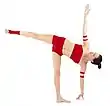Mysore style
The Mysore style of asana practice is the way of teaching yoga as exercise within the Ashtanga Vinyasa Yoga tradition as taught by K. Pattabhi Jois in the southern Indian city of Mysore; its fame has made that city a yoga hub with a substantial yoga tourism business.[1][2]
Method
This method differs from the usual way of teaching yoga. The class is not "led" as a whole, but rather all instruction is one-on-one within the group class setting. Students practice their own portion of the Ashtanga sequence of asanas at their own pace.[3] The teacher assists each student individually by giving physical adjustments & verbal instruction.
Style
In Mysore style, students learn the fixed order of asanas combining movement with free breathing, with sound. Through vinyasa, there is continuity via the breath from one asana to the next, so that each asana builds from the previous one.
Each student is given a yoga routine according to their ability. Newer and beginner students tend to have a much shorter practice than do those with more experience. As one gains more strength, stamina, flexibility and concentration, additional asanas are given to the student. The sense of the word "given" in this context comes from how the practice is taught in India, where a yoga practice is something that a teacher gives to a student as a spiritual practice. In the West, people are accustomed to learning a lot of asanas all at once – such as in a typical modern "led" yoga class.[4]
Structure
Asanas are given, one by one in a sequential order.[5] The structure of the class depends on the teacher being able to keep track of what every student is doing with a quick glance. If students attempt something out of sequence, the teacher is less able to help in the appropriate way. If a student has trouble with a particular asana, the teacher can offer a modification consistent with the intention of the practice. One by one also means that once a student is given a new asana, they practice their sequence up to that asana, then do backbends if applicable (backbending is the climax, not a part of the finishing sequence), and then wind down with the finishing sequence.
Deep teacher-facilitated backbends may have a trauma-releasing effect which can range from subtle feelings arising, through to cathartic releases of trauma viewed as being stored in the body. Crying or euphoria are common, usually followed by a general sense of clearing or release and emotional centering. In general, the next asana in the sequence should be added/taught/learned only after obtaining stability in one's last asana.[6]
As a practice
Ashtanga Vinyasa Yoga is intended to be a daily practice. Traditionally, practice takes place every day except for Saturdays and full or new moon days.[7]
See also
References
- "Mysore style yoga". Yoga is youthfulness. Retrieved 29 November 2013.
- Ward, Mariellen (15 March 2012). "How to 'do' a yoga ashram in India".
- Pizer, Ann. "What is Mysore Yoga?". About.com Yoga.
- MacGregor, Kino. "The Logic of the Six Day a Week Mysore Style Ashtanga Yoga Method". Kino Yoga. Retrieved 29 November 2013.
- Macgregor, Kino (2013). The Power of Ashtanga Yoga. Boston: Shambhala Publications. ISBN 1611800056.
- Fawer, Melanie. Mysore Style Ashtanga Yoga.
- Swenson, David (2007). Ashtanga yoga : The practice manual. Ashtanga Yoga Productions. ISBN 1891252089.
